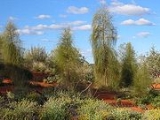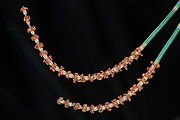
Allocasuarina
Encyclopedia


Genus
In biology, a genus is a low-level taxonomic rank used in the biological classification of living and fossil organisms, which is an example of definition by genus and differentia...
of trees in the flowering plant
Flowering plant
The flowering plants , also known as Angiospermae or Magnoliophyta, are the most diverse group of land plants. Angiosperms are seed-producing plants like the gymnosperms and can be distinguished from the gymnosperms by a series of synapomorphies...
family Casuarinaceae
Casuarinaceae
Casuarinaceae is a family of dicotyledonous flowering plants placed in the order Fagales, consisting of 3 or 4 genera and approximately 70 species of trees and shrubs native to the Old World tropics , Australia, and the Pacific Islands...
. They are endemic
Endemic (ecology)
Endemism is the ecological state of being unique to a defined geographic location, such as an island, nation or other defined zone, or habitat type; organisms that are indigenous to a place are not endemic to it if they are also found elsewhere. For example, all species of lemur are endemic to the...
to Australia
Australia
Australia , officially the Commonwealth of Australia, is a country in the Southern Hemisphere comprising the mainland of the Australian continent, the island of Tasmania, and numerous smaller islands in the Indian and Pacific Oceans. It is the world's sixth-largest country by total area...
, occurring primarily in the south. Like the closely related genus Casuarina
Casuarina
Casuarina is a genus of 17 species in the family Casuarinaceae, native to Australasia, southeast Asia, and islands of the western Pacific Ocean. It was once treated as the sole genus in the family, but has been split into three genera .They are evergreen shrubs and trees growing to 35 m tall...
, they are commonly called sheoaks or she-oaks, they are notable for their long, segmented branchlets that function as leaves. Formally termed cladodes, these branchlets somewhat resemble pine
Pine
Pines are trees in the genus Pinus ,in the family Pinaceae. They make up the monotypic subfamily Pinoideae. There are about 115 species of pine, although different authorities accept between 105 and 125 species.-Etymology:...
needles, although sheoaks are actually flowering plant
Flowering plant
The flowering plants , also known as Angiospermae or Magnoliophyta, are the most diverse group of land plants. Angiosperms are seed-producing plants like the gymnosperms and can be distinguished from the gymnosperms by a series of synapomorphies...
s. The leaves
Leaf
A leaf is an organ of a vascular plant, as defined in botanical terms, and in particular in plant morphology. Foliage is a mass noun that refers to leaves as a feature of plants....
are reduced to minute scales encircling each joint. Fallen cladodes form a dense, soft mat beneath sheoaks, preventing the development of undergrowth and making sheoak woods remarkably quiet.
Another characteristic feature are the spiny "cones", about the size of an acorn
Acorn
The acorn, or oak nut, is the nut of the oaks and their close relatives . It usually contains a single seed , enclosed in a tough, leathery shell, and borne in a cup-shaped cupule. Acorns vary from 1–6 cm long and 0.8–4 cm broad...
but with a texture more resembling a conifer cone
Conifer cone
A cone is an organ on plants in the division Pinophyta that contains the reproductive structures. The familiar woody cone is the female cone, which produces seeds. The male cones, which produce pollen, are usually herbaceous and much less conspicuous even at full maturity...
. However, sheoak "cones" are actually a woody fruit
Fruit
In broad terms, a fruit is a structure of a plant that contains its seeds.The term has different meanings dependent on context. In non-technical usage, such as food preparation, fruit normally means the fleshy seed-associated structures of certain plants that are sweet and edible in the raw state,...
. Male specimens bear no fruit and are sometimes colloquially referred to as a "heoak".
As with legumes, sheoak roots possess nodules containing symbiotic nitrogen fixing
Nitrogen fixation
Nitrogen fixation is the natural process, either biological or abiotic, by which nitrogen in the atmosphere is converted into ammonia . This process is essential for life because fixed nitrogen is required to biosynthesize the basic building blocks of life, e.g., nucleotides for DNA and RNA and...
bacteria; together with their highly drought
Drought
A drought is an extended period of months or years when a region notes a deficiency in its water supply. Generally, this occurs when a region receives consistently below average precipitation. It can have a substantial impact on the ecosystem and agriculture of the affected region...
-adapted foliage, this enables sheoaks to thrive in very poor soil and semi-arid areas. However, sheoaks are much less bushfire-tolerant than eucalypt
Eucalypt
Eucalypts are woody plants belonging to three closely related genera:Eucalyptus, Corymbia and Angophora.In 1995 new evidence, largely genetic, indicated that some prominent Eucalyptus species were actually more closely related to Angophora than to the other eucalypts; they were split off into the...
s.
Fossil
Fossil
Fossils are the preserved remains or traces of animals , plants, and other organisms from the remote past...
s of closely related species have been found dating back to the time of Gondwana
Gondwana
In paleogeography, Gondwana , originally Gondwanaland, was the southernmost of two supercontinents that later became parts of the Pangaea supercontinent. It existed from approximately 510 to 180 million years ago . Gondwana is believed to have sutured between ca. 570 and 510 Mya,...
.
Uses
The hard wood and rich texture makes sheoak wood popular among wood-turners. Sheoak wood is also regarded as an excellent firewood as it burns with very little ash.Because of its ability to grow and develop extensive root systems in very poor or sandy soils, and to completely cover the ground with its "needles", it is often used to stabilise soils in erosion
Erosion
Erosion is when materials are removed from the surface and changed into something else. It only works by hydraulic actions and transport of solids in the natural environment, and leads to the deposition of these materials elsewhere...
prone areas, or on sand dunes. Sheoak is also used as an ornamental shrub
Ornamental plant
Ornamental plants are plants that are grown for decorative purposes in gardens and landscape design projects, as house plants, for cut flowers and specimen display...
, although for this purpose the mat of "needles" may become a nuisance and must be carefully considered.
List of species
|
Allocasuarina luehmannii Allocasuarina luehmannii is a species of she-oak native to Australia. Stands are endangered by farming practices in the Wimmera region of western Victoria, where it is integral to the survival of the endangered southeastern subspecies of the Red-tailed Black Cockatoo for feeding and nesting.The... (Bull-oak or Buloke) Allocasuarina nana Allocasuarina nana, commonly known as the Dwarf She-Oak, is a small plant found in eastern Australia. Often seen around one metre tall, it grows in exposed heathlands, ridges, clifftops on sandstone based soils... Allocasuarina portuensis Allocasuarina portuensis, commonly known as the Nielsen Park She-Oak, is an extremely rare plant growing in Sydney, Australia. Encountered as a shrub or small slender tree, up to 5 metres tall, it has green drooping branchlets up to 27 cm in length. It is dioecious, that is, male and female...
|
External links
- She-Oak Woodland & Forest (Tasmania Government)
- Research team from IRD working on CasuarinaceaeCasuarinaceaeCasuarinaceae is a family of dicotyledonous flowering plants placed in the order Fagales, consisting of 3 or 4 genera and approximately 70 species of trees and shrubs native to the Old World tropics , Australia, and the Pacific Islands...

